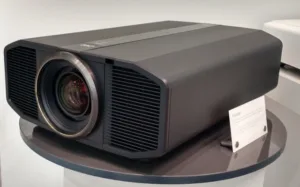JVC used IFA to launch its newest home theater projector with a native 4K (4096 x 2160) resolution set of D-ILA imagers. These imagers are new too at only 0.69″ in diagonal – that’s a tiny 3.8 micron pixel pitch. This appears to be the densest imager that JVC has made to date. Called the DLA-Z1, it will be shown again in the US at CEDIA. The target price in Europe is €35,000 and it should ship in November 2016.
We saw a demo of some HDR10 content from a Panasonic Ultra HD Blu-Ray disc in the HDR10 format along with content captured using the HLG format. Apparently, the projector has the PQ EOTF gamma curves built into the projector, but it was unclear if JVC has also added the inverse HLG EOTF. The content looked good, but did not have the punch we have seen in other flat panel demos of HDR.
The projector offers about 3000 ANSI lumens in a bright mode, but in an HDR mode, where it can achieve 100% of the P3 color gamut (or 80% of the BT.2020 gamut), the peak lumen output is somewhere between 1500 and 2000 lumens. This image was projected on 130″ Stewart Grayhawk screen with a gain of 0.9. I have not done the math to determine what the peak luminance would be on this screen, but I bet it is in the 200-400 cd/m² range or about the luminance of an average TV.
The demo room was dark and these projectors should have good contrast, but they do not achieve the ‘pop’ you want from an HDR image. We asked what the contrast was and were told it has not been measured, but other high-end JVC projectors can achieve 50K to 100K:1 contrast so they are clearly working toward that goal. That should create really great black levels, but you need a dark room to really appreciate them.
The projector can perform dynamic dimming on a scene by scene basis meaning it shift its native contrast up or down by varying the light output of the solid state light source. That is not qute real HDR however, as the full range of contrast needed to be available in every scene.
HDR10 content is mastered at a peak luminance of 1000 cd/m² – higher than what the projector will typically produce (unless you use a very small screen), so it needs to be tone mapped to this lower luminance range inside the projector. JVC is still working on this tone mapping feature, which may help to restore some of the punch to the image.
JVC said the HLG content was specifically graded for their projector which presumably means it was optimized to fit the projector’s peak luminance performance – and perhaps to fit the PQ EOTF. This content may have been a bit brighter in the white parts, but there was a lot of loss in detail there as well, suggesting very aggressive tone mapping. The internal image processing engine in the projector is 12-bit while the HDR10 and HLG content comes in as 10-bit.
This is also a laser phosphor projector and branded as BLU-Escent. JVC offers a BLU-Escent laser phosphor projector in its professional line, but these use e-shift technology, which means a 1080 panel set and an image-shifting optic to get close to 4K resolution.
The laser phosphor engine differs between the new home theater model and the professional model as well. In the professional model, the yellow phosphor is placed on a rotating wheel. In the home theater model, it is placed on a stationary substrate, presumably, a reflective one. The back of the substrate is then cooled with a heat pipe and cooling fins with a fan. They did this for two reasons; to reduce noise from the rotating wheel and to increase reliability be eliminating the phosphor wheel motor. Lifetime remains the same however, at 20K hours to 50% of initial luminance.
Lensing for the projector has been improved to support native 4K MTF using 18 elements. The optics are also large at 100 mm diameter. There is also 100% vertical and 30 % horizontal lens shifting. It has two HDMI 2.0a connectors each supporting 18 Gbps signals for 4K/60 at 4:4:4. The housing is a nice brushed aluminum.
It is ISF (Imaging Science Foundation) certified and is currently being tested for THX 4K certification. – CC

